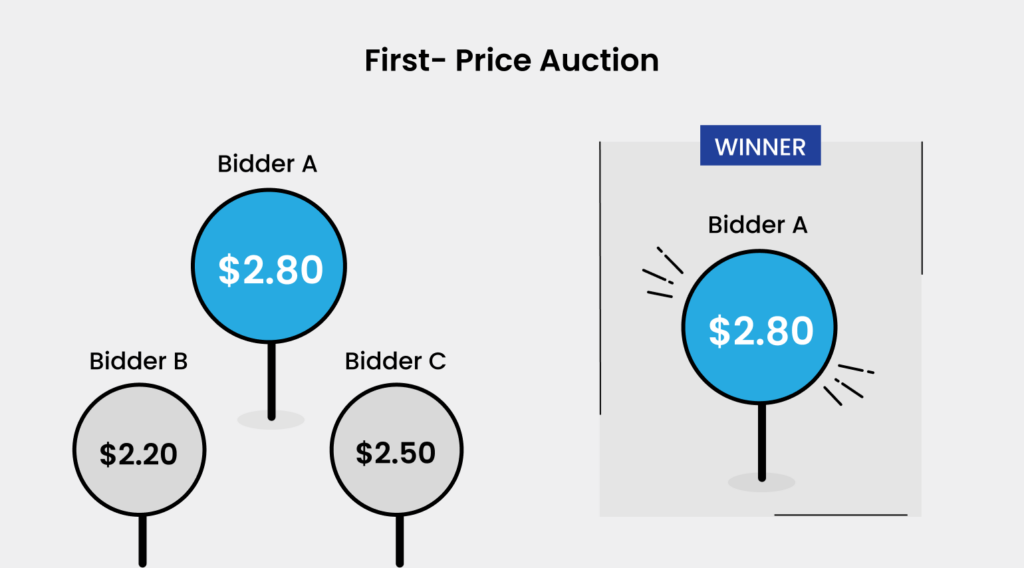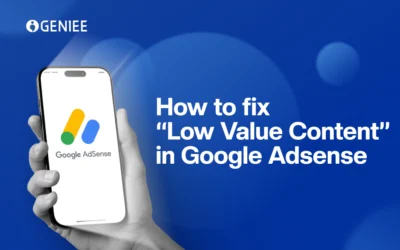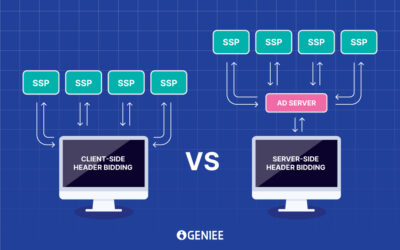
| One of the key findings from The Drum found out that more than 50% of media buyers and sellers lacked understanding of auction dynamics, and this blog will explain the workings of first-price and second-price auctions. |
Programmatic advertising has revolutionized the digital marketing landscape in recent years, transforming how advertisers and publishers operate.
Real-Time Bidding (RTB) and programmatic technologies have reshaped the advertising world. As you embark on your journey with RTB, it’s crucial to understand the two main types of auctions: first-price and second-price.
Traditionally, the ad tech market relied on second-price auctions as they were easier to navigate in a waterfall setup. However, the evolution of header bidding has changed the game, enabling buyers to see and assess greater amounts of inventory at once. As innovations in the industry never stop, bringing new challenges, Google announced its transition to a unified first-price auction for publisher inventory.

Despite these advancements, almost half of buyers remain unaware of the basic differences between first-price and second-price auctions, according to The Drum.

This lack of understanding can hinder brands from determining the optimal price to pay to get the best value from your media.
Today, it’s more important than ever for brands to learn more about these auction types to maximize the value of their ads.
Let’s now get to the heart of the matter and understand what exactly these auctions are and how they differ from each other.
What is the First-Price Auction?
First-price auction is a bidding model in digital advertising where the highest bidder wins the auction and pays exactly what they bid for the ad impression.
This straightforward approach maximizes revenue potential for publishers, as they receive the highest bid amount directly. Besides, also provides transparency, allowing both publishers and advertisers to see the actual cost of the impression and know about fees taken by SSPs or Ad Exchange.
With 78% of publishers reporting increased ad revenues after transitioning to first-price auctions, it’s clear this approach can enhance ad revenue.
However, publishers must be aware of market values to avoid overpricing, which can reduce demand for their inventory. Understanding the fair market value of impressions and the auction mechanics is crucial.
How does First-Price Auction Work (Example)?
To illustrate how a first-price auction works, let’s consider an example with three bidders: A, B, and C.
Each bidder submits their bid for 1,000 ad impressions:
- Bidder A: $2.20
- Bidder B: $2.80
- Bidder C: $2.50
In a first-price auction, the highest bid wins. Therefore, Bidder B wins the auction with a bid of $2.80. As per the rules of a first-price auction, Bidder B pays exactly what they bid, which is $2.80 per 1,000 impressions. This payment goes directly to the publisher.

This model can maximize revenue for publishers as it captures the highest possible bid amount. However, it can also lead to intense competition among bidders, who may inflate their bids to secure the inventory, potentially leading to a price war. Over time, if bidders feel they are overpaying without getting sufficient returns, it could reduce demand for the publisher’s inventory.
Benefits of First-Price Auctions
Revenue Maximization
Publishers can achieve higher revenues as the winning bid reflects the maximum amount a buyer is willing to pay.
Transparency
Both publishers and advertisers know the exact transaction price, fostering trust and making it easier to predict revenue and costs.
Simplicity
The straightforward nature of first-price auctions simplifies the bidding process, reducing operational complexities for publishers.
True Value Bidding
Bidders are encouraged to bid what they believe the impression is worth, potentially leading to more accurate market pricing.
Limitations of First-Price Auctions
Potential for Overpricing
The intense competition may lead to overpricing, where advertisers bid higher than the true value of the impression, which can result in wasted ad spend and deter future participation.
Reduced Demand
If advertisers frequently feel they are overpaying, they may pull back on their bids or avoid certain inventories, leading to reduced demand over time.
Price Volatility
The auction prices can be highly volatile, making it challenging for publishers to maintain consistent revenue and for advertisers to predict costs.
Bid Shading Complexity
To avoid overpaying, advertisers may employ bid shading strategies, which involve bidding slightly lower than their true value. This adds complexity to the bidding process and requires sophisticated algorithms and technology.
What is the Second-Price Auction?
In the second-price auction, the highest bidder also wins. However, the winner typically pays the price of the second-highest bid plus $0.01.
This approach encourages advertisers to bid their true value since they know they will likely pay less than their maximum bid. It also fosters transparency, allowing advertisers to understand the competitive landscape and manage costs effectively.
However, while advertisers benefit from potentially lower costs, publishers may face reduced revenues since the final price paid is not the highest bid. Despite this, the second-price auction remains popular due to its efficiency and fairness in determining market value.
How does Second-Price Auction Work (Example)?
Let’s take the same example as the first-price auction. Each bidder submits their bid for 1,000 ad impressions:
- Bidder A: $2.20
- Bidder B: $2.80
- Bidder C: $2.50
In a second-price auction, the highest bid wins. Therefore, Bidder B wins the auction with a bid of $2.80. However, Bidder B pays the price of the second-highest bid, which is “Bidder C” plus $0.01. Now, the final cost stands at $2.51 per 1,000 impressions. This payment goes directly to the publisher.

This model can result in cost savings for advertisers, as they do not have to pay their full bid amount, thus encouraging higher participation. However, publishers may see lower revenues compared to first-price auctions.
Benefits of Second-Price Auctions
Predictable Revenue
Second-price auctions provide a predictable and transparent pricing mechanism, making it easier for publishers to forecast earnings and for advertisers to plan their budgets.
Encourages Competitive Bidding
Advertisers are motivated to bid their true value, as they know they will pay slightly more than the second-highest bid, potentially leading to higher bids overall.
Transparency and Trust
The auction model promotes transparency, which helps build trust with advertisers and fosters a fairer competitive environment.
Limitations of Second-Price Auctions
Lower Revenue Potential
Publishers may earn less than the highest bid, as the winning bidder only pays the amount of the second-highest bid plus a small increment, potentially reducing overall revenue.
Hidden Fees
Second-price auctions can involve hidden fees from SSPs, which can further diminish the net revenue received by publishers.
Complex Auction Dynamics
The complexity of integrating real-time bidding and header bidding in second-price auctions can lead to operational inefficiencies and make the process harder to manage.
Underbidding Risk
Advertisers might place lower bids, knowing they won’t pay their maximum bid, leading to undervaluation of premium inventory and reduced demand for high-quality ad placements.
First-Price vs Second-Price Auction Dynamics Comparison
Understanding the differences between first-price and second-price auctions is crucial for publishers navigating the complex landscape of digital advertising. Let’s break down the comparison between these auction types and explore how bid shading has emerged as a strategic tool in this evolving ecosystem.
Let’s get back to the price auction example presented above and look at the results of a first-price vs second-price auction.
- Bidder A: $2.20
- Bidder B: $2.80
- Bidder C: $2.50
In a first-price auction, Bidder B wins with their bid of $2.80, and that’s the amount they pay.
However, in a second-price auction, Bidder B still wins but the clearing price is calculated as $0.01 plus the second-highest bid ($2.50), resulting in $2.51. This slight difference between the bid and what’s paid is known as the reduction.
With the switch toward first-price auctions, the fear of overpriced impressions has led to Bid Shading.
What is Bid Shading?
Bid shading is a technique buyers use in first-price auctions to avoid overpaying.
This technique involves buyers forecasting the market value for a given impression, in order to determine the actual bid price to submit. It is based on various factors such as site, ad size, exchange, and competitive dynamics. By doing so, buyers adjust their bid price to align with the anticipated value, effectively shading their bids.
However, bid shading can impact publishers’ revenue by potentially lowering the final payment for ad space, with estimates suggesting it could steal up to 20% of publishers’ ad revenue. To counter this, publishers are implementing an intelligent Floor Price Strategy.
How has the Floor Price Strategy Changed?
Traditionally, setting floor prices served as a key tactic for publishers to boost auction closing prices, especially in second-price auctions. This strategy often led to quick revenue boosts.
But now, digital advertising is changing. First-price auctions and Header Bidding are becoming more common. Floor prices don’t directly impact the final payment. Instead, publishers must rethink their floor price strategies to remain competitive.
To stay ahead, publishers need to adjust their floor price tactics.
Google’s introduction of unified pricing rules aims to assist publishers in optimizing their floor prices amidst these changes. Publishers are advised to tailor their floor prices based on different inventory segments. Instead of just aiming for high closing prices, they must anticipate aggressive bidding in first-price auctions.
Conclusion
In summary, programmatic advertising has transformed digital marketing through Real-Time Bidding (RTB) and programmatic technologies. Understanding the differences between first-price and second-price auctions is crucial.
While first-price auctions offer transparency and revenue potential, they risk overpricing. Second-price auctions provide predictability but may lead to lower revenues. Navigating these complexities requires a deep understanding of auction mechanics and strategic approaches. Staying informed and adaptable is key to maximizing advertising investments in this evolving landscape.
Frequently Asked Question
1. Is eBay the First or Second-Price auction?
eBay primarily utilizes a second-price auction model. In this auction format, the highest bidder wins the item but pays the price of the second-highest bid plus a small increment.
2. How Bid Shading works in the context of programmatic advertising auctions?
Bid shading is a technique used by advertisers in first-price auctions to adjust their bids based on the perceived market value of an impression. By forecasting the value and shading their bids accordingly, advertisers can avoid overpaying and optimize their bidding strategies.
3. What are challenges that publishers might face when transitioning from Second-Price to First-Price auctions?
Transitioning from second-price to first-price auctions can pose challenges for publishers, including the need to adapt to new auction dynamics and potential revenue fluctuations. Publishers must also carefully manage pricing strategies to avoid overpricing impressions and maintain advertiser demand.




0 Comments